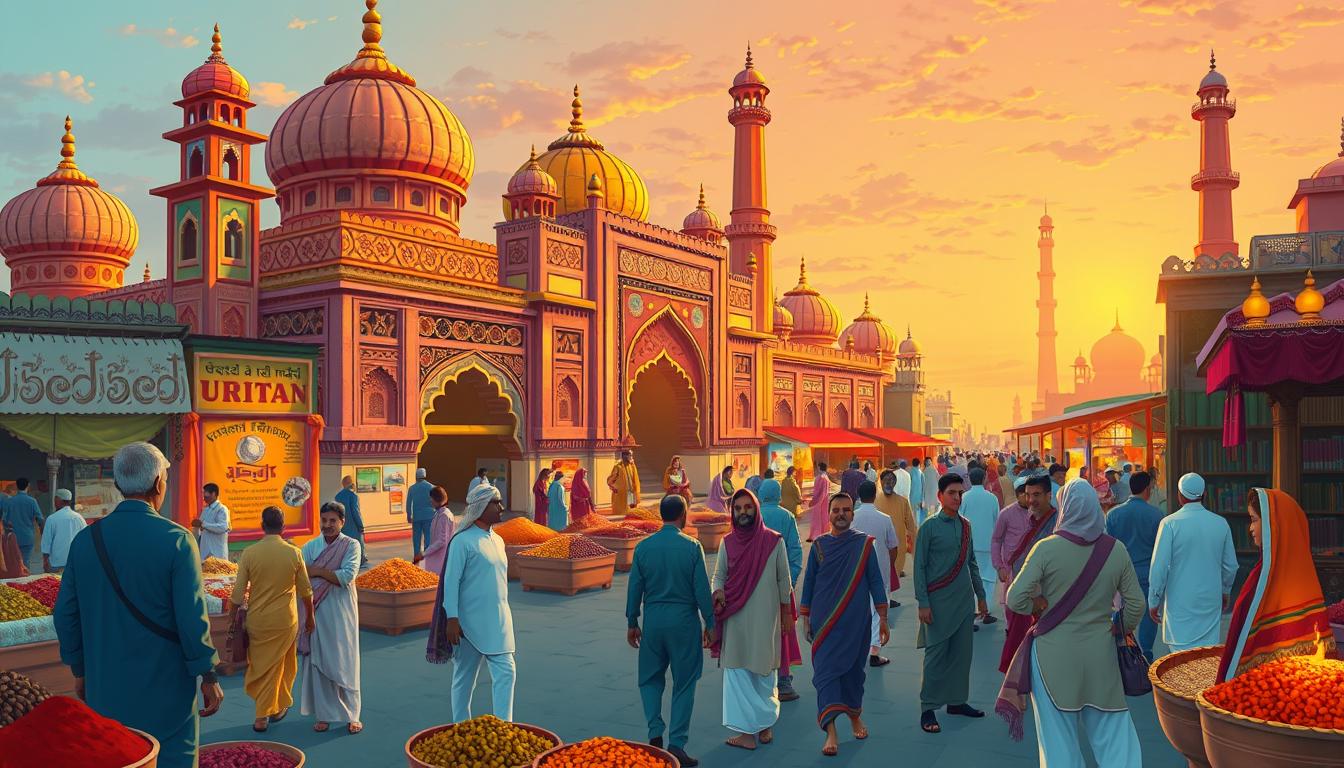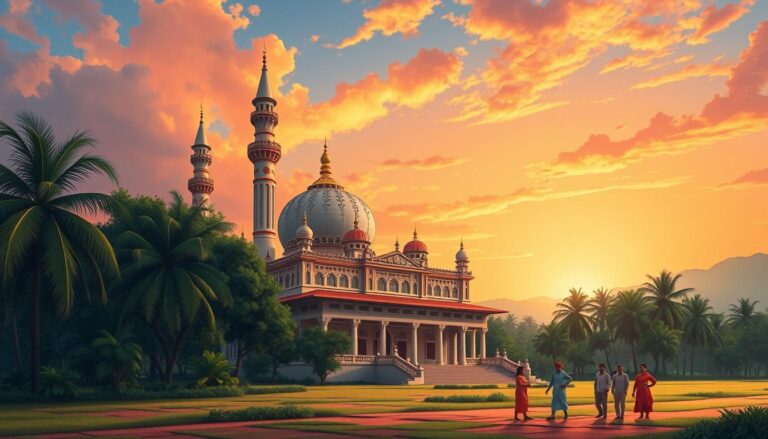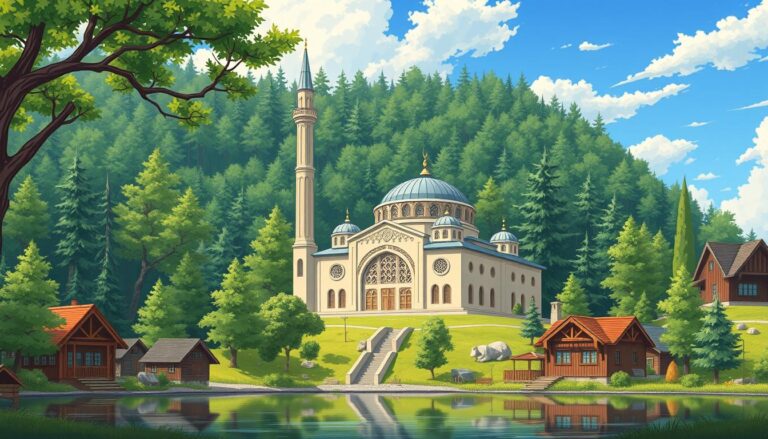Islam in India
India, a land of immense cultural and religious diversity, boasts a significant Muslim population that accounts for approximately 172.2 million people, or 14.2% of the country’s total population. This makes India the country with the third-largest Muslim population globally, following only Indonesia and Pakistan. Islam’s presence in the Indian subcontinent dates back centuries, with its early arrival through coastal trade routes and subsequent spread into the heartland, shaping the region’s rich tapestry of history, culture, and heritage.
Key Takeaways
- India has the third-largest Muslim population globally, comprising around 172.2 million people or 14.2% of the total population.
- Islam arrived in India through coastal trade routes and later spread into the heartland, leaving a lasting impact on the region’s history, culture, and heritage.
- The majority of India’s Muslims are Sunni, with a smaller Shia population of around 15%.
- Islam has become an integral part of India’s diverse religious and cultural landscape, with Muslim rulers, art, architecture, and festivals contributing to the country’s Indo-Islamic civilization.
- Despite being a significant minority, Muslims in India have faced challenges, including political under-representation and discrimination in various areas.
A Diverse and Significant Minority
India is home to the world’s third-largest Muslim population, with around 172 million Muslims making up 14.2% of the country’s total population. While often portrayed as a monolithic community, the diversity within the Indian Muslim population is remarkable.
India’s Muslim Population: Size and Composition
The Muslim population in India is concentrated in specific states such as Uttar Pradesh, Bihar, West Bengal, Kerala, and Assam. Muslims also form a majority in the state of Jammu and Kashmir. However, despite their significant numbers, Muslims have historically been underrepresented in legislative bodies, civil service, and institutions of higher education.
Regional Distribution and Diversity
Indian Muslims come from diverse ethnic and cultural backgrounds, with the vast majority belonging to South Asian ethnic groups. Some Indian Muslims also have traceable levels of gene flow from the Middle East and Central Asia, though in very low levels. The caste system among Muslims, with the Ashrafs claiming superior status due to their foreign Arab ancestry and the Ajlafs assumed to be converts from Hinduism, further adds to the complexity of the community.
“India’s Muslim population is diverse, with significant regional variations and a rich cultural heritage.”
The regional distribution of the Muslim population in India reflects this diversity, with sizable communities across various states, each with their unique customs, traditions, and linguistic affiliations.
Historical Roots and Spread of Islam
The history of Islam’s arrival and spread in India dates back centuries. Trade relations between the Indian subcontinent and the Arabian Peninsula have existed since ancient times, with Arab traders regularly visiting the Konkan-Gujarat coast and Malabar Coast, which were connected to the ports of Southeast Asia. These early trade routes facilitated the first encounters between newly Islamized Arabs and the Indian population, with the first Muslim travelers sighted on the Indian coast as early as 630 CE.
Early Trade Routes and Coastal Influences
The spread of Islam in India was closely tied to the development of maritime trade routes. As Arab merchants and sailors expanded their commercial activities, they established a presence along the Indian coastline, particularly in regions like Gujarat and the Malabar Coast. This allowed for the gradual diffusion of Islamic beliefs and practices, influencing the local populations through commercial and cultural exchanges.
Arrival in the Indian Heartland
While the initial Islamic influence was concentrated on the Indian coast, the religion later expanded inland, arriving in the 7th century when the Arabs conquered the region of Sindh. Over the subsequent centuries, Islam continued to spread throughout the Indian heartland, reaching Punjab and North India in the 12th century through the conquests of the Ghaznavids and Ghurids.
The integration of Islam with the existing cultural and religious landscape of the Indian subcontinent led to the development of diverse Islamic traditions and the creation of a significant Muslim population, which today accounts for approximately 14.2% of India’s total population.
“The spread of Islam in India was a gradual and multifaceted process, shaped by trade, conquest, and cultural exchange over several centuries.”
Cheraman Perumal and the First Mosques
One of the earliest accounts of Islam’s arrival in India can be traced back to the story of Cheraman Perumal, the last ruler of the Chera dynasty in Kerala. According to legend, Cheraman Perumal converted to Islam during the lifetime of Prophet Muhammad (c. 570–632) and subsequently commissioned the construction of the first Indian mosque in Kodungallur, Kerala, around 624 CE.
Similarly, Tamil Muslims on the eastern coasts of India claim that they too converted to Islam during Muhammad’s time, with local mosques dating back to the early 700s. Three of the earliest mosques in India are the Barwada Mosque in Ghogha, Gujarat (built before 623 CE), the Cheraman Juma Mosque (629 CE) in Methala, Kerala, and the Palaiya Jumma Palli (or The Old Jumma Masjid, 628–630 CE) in Kilakarai, Tamil Nadu.
The Cheraman Juma Mosque is considered the first mosque in India and is believed to be the second mosque globally where Juma (Friday) prayers were initiated. The original mosque, which followed the Kerala architectural style with hanging lamps, was destroyed by the Portuguese in 1504 but was later rebuilt in the mid-16th to early 17th century.
“The Cheraman Juma Mosque is claimed to be the first mosque built in India in 629 CE.”
The 1984 renovations of the mosque featured modern corridors and halls, concealing most of the exterior features of the old building. However, the community of Mapilla, formed by Arab traders who integrated into Kerala society in the 13th-14th centuries, still maintains the Sunni Islamic teachings within the mosque.
While the legend of Cheraman Perumal’s conversion to Islam is debated among historians, with some considering it fictitious, the Cheraman Juma Mosque remains an important symbol of early Islamic architecture in India.
Genetic Origins and Ethnic Diversity
The Muslim population in India is a diverse and fascinating community, comprising over 138 million people and representing about 13% of the country’s total population. Contrary to popular perception, the genetic origins of Indian Muslims reveal a complex and nuanced story, with their ancestry deeply rooted in the local South Asian ethnic groups.
Studies on the genetic profiles of Indian Muslims have shown that the vast majority are genetically similar to their non-Muslim geographical neighbors, with only minor detectable levels of gene flow from outside the region, primarily from Iran and Central Asia, rather than directly from the Arabian Peninsula. This suggests that the spread of Islam in the Indian subcontinent was largely a cultural transformation phenomenon, with limited genetic impact on the local populations.
South Asian Ethnic Groups and Foreign Influences
The genetic diversity within the Indian Muslim community is a reflection of the country’s rich ethnic tapestry. While some Muslims in northern and northwestern India exhibit a higher proportion of genetic lineages of external origin, the majority of Indian Muslims are closely related to the neighboring non-Muslim populations, with many being descendants of local Hindu converts.
- Detailed genetic analyses have found that Indian Muslims have a high regional genetic affinity, with strict endogamy practices observed within different Muslim communities, such as Shia, Sunni, and groups like the Dawoodi Bohra and Mappla.
- The genetic signatures of the Middle East have been detected in some contemporary Indian Muslim populations, suggesting minor admixture from these regions over time.
- However, the overwhelming majority of Indian Muslims share a common genetic heritage with their non-Muslim counterparts, with the spread of Islam in the region being primarily a cultural phenomenon rather than a significant genetic event.
The genetic origins and ethnic diversity of Indian Muslims are a testament to the rich tapestry of cultures that have shaped the country’s history. While the Muslim community in India is a significant minority, their genetic profiles reflect the deep-rooted connections to the local South Asian populations, with only minor influences from outside the region.
Islam in India
Islam has become an integral part of India’s rich religious and cultural heritage since its arrival and spread in the country. The influence of this faith can be seen across various aspects of Indian civilization, from architecture and art to literature, music, and cuisine. Islamic empires like the Delhi Sultanate and the Mughal Empire have played a significant role in shaping the cultural and political landscape of India.
The role of Islam in India dates back to the 8th century, with the Umayyad campaigns in the northwestern subcontinent, particularly in modern-day Pakistan. Over the centuries, Muslim invasions and conquests continued, with Mahmud of Ghazni’s incursions into Punjab and Gujarat in the 11th century and the establishment of Muslim rule by Ghurid ruler Muhammad of Ghor in 1192.
The Muslim population in India has grown substantially over time, with their share in the country’s population rising by more than 43% from 1950 to 2015, increasing from 9.84% to 14.09%. During the same period, the share of the Hindu population decreased by 7.82%, declining from 84.68% to 78.06%.
The diverse Muslim communities in India have contributed to the country’s rich tapestry of ethnic and linguistic diversity. The influence of Islam on Indian culture can be seen in the architecture, art, literature, music, and cuisine that have been shaped by this faith.
“Islam has deeply influenced the cultural and social fabric of India, leaving an indelible mark on the nation’s identity.”
The role of Islam in India and its contribution to the country’s cultural heritage cannot be overstated. From the early trade routes and coastal influences to the establishment of Islamic empires, the presence of this faith has been a significant part of India’s long and diverse history.
The Partition and Its Impact
The Partition of India in 1947, which led to the creation of the independent nations of India and Pakistan, was a defining moment in the history of the subcontinent. The hasty division along religious lines triggered a wave of communal violence and mass migrations that left a lasting impact on the region.
Historians estimate that between 200,000 and 2 million people were killed in the aftermath of the Partition. Approximately 15 million Hindus, Sikhs, and Muslims were forced to flee their homes, seeking refuge across the newly drawn borders. The Sikh community suffered the highest proportion of casualties relative to their numbers during this tumultuous period.
Communal Violence and Mass Migrations
The devastating violence during the Partition was a result of the British “divide-and-rule” strategy, which provided some electoral privileges for the Muslim minority, and the tensions between Hindu and Muslim political movements that rallied constituents along religious lines. The breakdown of law and order led to ethnic cleansing and horrific communal massacres.
The mass migrations that followed the Partition left an indelible mark on the national consciousness of India, Pakistan, and Bangladesh, impacting their citizens to this day. The large Sikh population in Punjab was effectively cut in half, leading to significant concerns and resulting in violent reprisals.
The Subsequent Constitutional Framework
The Indian constitution, drafted in the years following the Partition, enshrines egalitarian principles, including social equality and nondiscrimination. The word “secular” was added to the preamble in 1976, though the constitution does not explicitly require the separation of religion and government.
The legacy of the Partition continues to shape the relationship between India and Pakistan, as the two nations have engaged in three wars over the disputed boundaries in Kashmir. The traumatic effects of this historical event have had lasting consequences on individuals and subsequent generations, influencing attitudes toward various aspects of life.
Challenges Faced by Indian Muslims
Indian Muslims have long grappled with a range of challenges, from discrimination and prejudice to political under-representation. These issues have persisted despite the constitutional protections and commitments to equality promised in India.
Discrimination and Prejudice
Indian Muslims often face discrimination in areas such as employment, education, and housing. They frequently struggle to secure justice when subjected to acts of discrimination, as the judicial system has sometimes failed to hold perpetrators accountable. According to recent surveys, nearly half of the police personnel surveyed exhibited anti-Muslim bias, making them less likely to intervene and protect Muslims from violence.
Political Under-Representation
The representation of Muslims in India’s parliament has remained stagnant, with Muslims holding just 5% of seats after the 2019 elections. This lack of political representation has significant implications for the community’s ability to advocate for their interests and address the challenges they face. State and national courts, as well as government bodies, have also been accused of overturning convictions or withdrawing cases against Hindus accused of involvement in violence against Muslims.
The challenges faced by Indian Muslims are multifaceted and deeply rooted, requiring a concerted effort to address discrimination, ensure equal representation, and uphold the principles of justice and equality enshrined in the Indian Constitution.
“The violence against Muslims in India is a pattern of sporadic sectarian violence between Hindu and Muslim communities.”
The Rise of Hindu Nationalism
Hindu nationalism in India has deep roots, dating back to colonial-era writings that promoted the idea of Hindus as the “true sons of the soil” since their holy lands are within India, unlike the Christian and Muslim faiths. The Bharatiya Janata Party (BJP), founded in 1980 and tracing its origins to the political wing of the Hindu nationalist Rashtriya Swayamsevak Sangh (RSS), has played a significant role in the rise of Hindu nationalism.
The BJP and Its Ideology
The BJP came to power in 1998 and again in 2014 and 2019, with Narendra Modi as the prime minister. The party has pursued a Hindu nationalist agenda, which has led to the implementation of controversial policies that critics say explicitly target Muslims and restrict their religious freedoms.
Controversial Policies and Actions
- The Citizenship Amendment Act (CAA) and the proposed National Register of Citizens (NRC) have been criticized for their potential to disenfranchise millions of Muslims in India.
- The BJP-led government has been accused of ignoring the rights of Muslims and other minority groups, as well as promoting policies that are intended to consolidate Hindu power.
- In 2002, the state of Gujarat, where Narendra Modi was the chief minister, witnessed one of India’s bloodiest communal massacres since the Partition, with over 800 people, mostly Muslims, killed in sectarian violence.
The rise of Hindu nationalism in India has led to increased tensions between the Hindu majority and the Muslim minority, with concerns that the BJP’s policies and actions are contributing to a more polarized and intolerant society.
“The Sangh Parivar projects a strong Hindu nationalism, intending to bring India into a new era of glory.”
Population Growth and Fertility Rates
The Hindu majoritarian right has long pushed a conspiracy theory, the “population jihad,” suggesting that Indian Muslims reproduce faster with the intent of eventually outnumbering Hindus. However, the reality paints a different picture. According to government data, Muslim fertility rates are falling the fastest among all major religious groups in India.
The fertility rate among Muslims has dropped from 4.41 to 2.36 between 1992 and 2021, while it decreased from 3.3 to 1.94 for Hindus during the same period. This debunks the “population jihad” myth and demonstrates that the Muslim population growth is not disproportionate or driven by an agenda to outpace the Hindu population.
Debunking the “Population Jihad” Myth
Education levels, wealth indicators, and geographic location play a crucial role in fertility rates in India, affecting the number of children women tend to have. Religion is just one contributing factor, alongside historical, cultural, and socioeconomic elements. The data shows that population growth in India has slowed since the 1990s, with growth rates declining for all major religious groups, though more pronounced among religious minorities.
“The data used for these findings comes from India’s decennial census, the National Family Health Survey, the United Nations Population Division, and a Pew Research Center survey conducted among 29,999 Indian adults.”
The Hindu-Muslim population ratio has remained relatively stable, with Muslims accounting for 14.2% of India’s population in 2011, up from 9.8% in 1951. Meanwhile, the Hindu population has declined from 84.1% to 79.8% during the same period. These trends highlight the need to move beyond the “population jihad” myth and focus on evidence-based policies that address the underlying socioeconomic factors driving fertility rates across all religious communities.
The Citizenship Amendment Act and NRC
In December 2019, the Indian government passed the Citizenship Amendment Act (CAA), which expedites citizenship for non-Muslim minorities from neighboring countries who fled to India before 2014. This law has been widely criticized as it applies a religious test for the first time in independent India’s history, effectively discriminating against Indian Muslims.
The Citizenship Amendment Act allows for the fast-tracking of citizenship for Hindu, Sikh, Buddhist, Jain, Parsi, and Christian migrants from Afghanistan, Bangladesh, and Pakistan. However, it excludes Muslims, who make up a significant minority of over 200 million people in India’s population of 1.4 billion.
Critics argue that the CAA, combined with the planned nationwide National Register of Citizens (NRC), aims to disenfranchise millions of Indian Muslims. The NRC was first implemented in the state of Assam, where it left out nearly 2 million people, many of them Muslims. The government’s efforts to implement the CAA and NRC nationwide have sparked widespread protests, with over 100 people, mostly Muslims, killed in the clashes.
“The Citizenship Amendment Act legitimizes discrimination based on religion and goes against the secular principles of the Indian Constitution,” said Amnesty India.
The United States has also expressed concern over the CAA, stating that it will monitor how India implements the law. Protests against the CAA and NRC continue, with many fearing that these measures could lead to the denial of citizenship rights for a large segment of India’s Muslim population.
Conclusion
Islam has a significant and diverse presence in India, with a rich history of trade and cultural exchange dating back centuries. While India’s Muslim community faces various challenges, including discrimination and political under-representation, they have also made invaluable contributions to the country’s vibrant tapestry of religious and ethnic diversity. However, the rise of Hindu nationalism and controversial policies targeting Muslims have heightened religious tensions and threatened the secular ideals enshrined in India’s constitution.
Addressing these issues and ensuring the equal rights and representation of all citizens, regardless of faith, will be crucial for India’s continued harmony and progress. As the world’s largest democracy, India must uphold its commitment to pluralism and inclusive governance, fostering a society where all its diverse communities can thrive and prosper. The conclusion of this article highlights the need to understand the complex history, demographics, and contemporary dynamics of Islam in India, in order to promote mutual understanding and build a more just and equitable future for all.
The summary of key points underscores the significance of the Muslim population in India, their historical roots, the impact of partition and Hindu nationalism, as well as the ongoing challenges faced by the community. By recognizing the integral role of Islam in India’s history and embracing its diversity, the country can take meaningful strides towards fulfilling its democratic ideals and ensuring the equal rights and representation of all its citizens.
Source Links
- India’s Muslims: An Increasingly Marginalized Population
- World Directory of Minorities and Indigenous Peoples – India : Muslims | Refworld
- Muslims in India – Minority Rights Group
- 2. Diversity and pluralism
- 1 city, 2 people — and India’s widening religious divide
- Islam in India
- Did you know?: The Spread of Islam in Southeast Asia through the Trade Routes
- Trade and Geography in the Spread of Islam
- Cheraman Juma Mosque
- Cheraman Juma Masjid: Restoration of First Mosque in India (2021)
- A Shared Y-chromosomal Heritage between Muslims and Hindus in India
- Diverse genetic origin of Indian Muslims: evidence from autosomal STR loci – Journal of Human Genetics
- Traces of sub-Saharan and Middle Eastern lineages in Indian Muslim populations
- Muslim conquests in the Indian subcontinent
- Has India’s Muslim population really exploded?
- Partition of India | Summary, Cause, Effects, & Significance
- Partition of 1947 continues to haunt India, Pakistan
- Why was British India Partitioned in 1947? Considering the role of Muhammad Ali Jinnah
- Challenges to Islam in India
- Violence against Muslims in independent India
- The Rise of Hindu Nationalism and Its Regional and Global Ramifications – Association for Asian Studies
- The Rise of Hindu Nationalism
- Rising Hindu nationalism leaves Muslims fearful in India’s holy city | CNN
- Religious Composition of India
- 1. Population growth and religious composition
- Population rise not related to religion, highest decline in fertility rate among Muslims: NGO | India News – Times of India
- India’s new citizenship law excludes Muslims. Here’s what to know
- Why is India’s Citizenship Amendment Act so controversial?
- CAA: India’s new citizenship law explained
- How Islam Spread in India
- Indian Muslims – İnsamer – İnsamer







